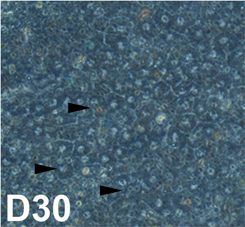
Nobuaki Shiraki, Taiji Yamazoe, Zeng Qin, Keiko Ohgomori, Katsumi Mochitate, Kazuhiko Kume and Shoen Kume (2011) Efficient differentiation of embryonic stem cells into hepatic cells in vitro using a feeder-free basement membrane substratum, PLoS One 6(8): e24228. doi:10.1371/journal.pone.0024228
The endoderm-inducing effect of the mesoderm-derived supportive cell line M15 on embryonic stem (ES) cells is partly mediated through the extracellular matrix, of which laminin α5 is a crucial component. Mouse ES or induced pluripotent stem cells cultured on a synthesized basement membrane (sBM) substratum, using an HEK293 cell line (rLN10-293 cell) stably expressing laminin-511, could differentiate into definitive endoderm and subsequently into pancreatic lineages. In this study, we investigated the differentiation on sBM of mouse and human ES cells into hepatic lineages. The results indicated that the BM components played an important role in supporting the regional-specific differentiation of ES cells into hepatic endoderm (Figure). We show here that knockdown of integrin β1 (Itgb1) in ES cells reduced their differentiation into hepatic lineages and that this is mediated through Akt signaling activation. Moreover, under optimal conditions, human ES cells differentiated to express mature hepatocyte markers and secreted high levels of albumin. This novel procedure for inducing hepatic differentiation will be useful for elucidating the molecular mechanisms controlling lineage-specific fates during gut regionalization. It could also represent an attractive approach to providing a surrogate cell source, not only for regenerative medicine, but also for pharmaceutical and toxicologic studies.

Figure. Human ES cells (KhES-3) grown on sBM for 30 days. Polygonal cells were observed (arrowheads).